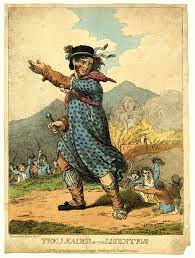Warning: the following blog post contains homework for readers. Turn away now should you wish to not do any work.
Among the many things I've done to occupy my brain during this existence period (
hat tip: Richard Ford) is write. Blog posts, LinkedIn articles, a poem or two, and as you may know, two whole children's books. The latest of those books was inspired by the daily walks I take with my dog through
our little pedestrian-friendly home town.
It occurred to me that there are probably people who visit historic towns like mine and poke around in the various shops that would be willing to pay for quirky local color. And since that notion popped into my brain while I was walking my dog, it turned into an idea for a series of histories of little towns with some dog-centric angle. And so was born "The Adventures of JoJo the Small-Town Hound".
This is where the homework comes in. The following is the draft text of "Volume 1: Leesburg, Virginia and the Curious Case of Dog Money". Your job is to critique it and tell me how I can make it better. My wife has given me some notes, including adding more JoJo-specific adventuring. I'd welcome yours. In exchange, I'll credit you in the Acknowledgements and buy the first round at the publishing party.
The Adventures of JoJo The Small Town Hound
Vol. 1, Leesburg, Virginia and the Curious Case of Dog Money
This is JoJo. She’s a friendly pup with a unique hobby. She loves touring small towns, meeting their people and learning their history. (Her humans think she just likes to eat treats, but that’s just how she gets them to take her places.)
JoJo was born in Mississippi, but she lives in Virginia now. She asked me to write this book so she could share one of her favorite places with you.
Leesburg, Virginia is in the northeast part of the state, near both the Maryland and West Virginia borders, and about 40 miles northwest of the Nation’s Capital. It’s the county seat of Loudoun County, complete with a courthouse. JoJo wants me to tell all her canine friends that the Law Library in the courthouse complex always has dog treats available for four-legged visitors.
The town was established officially by the Assembly of Virginia in 1758, meaning that there are more than 250 years of smells for good dogs to sniff. It also means that the town has experienced American history in a number of interesting ways.
During the American Revolution, Loudoun County was home to the largest militia in Virginia, with more than 1,700 residents taking up arms. Later, as the British threatened Washington, D.C. in the War of 1812, the U.S. Constitution and Declaration of Independence were hidden in Leesburg to keep them safe.
JoJo was happy to learn those things about the town, but she really perked up when she heard about Dog Money.
Because of its location on the border between the South and the North, the U.S. Civil War was a complicated time for Leesburg. As a town in Virginia, it was a part of the Confederate States of America, but like much of America, the townspeople’s loyalties were divided, with some serving in the Union Army and others in the Confederate Army.
Leesburg changed hands more than 150 times between 1861 and 1865 as the warring armies battled against each other. Among other things, this made it very complicated for townspeople to know which kind of money to use, depending on who was in control of the town. So the town got creative and made up its own money.
A man named Martin Casey designed Leesburg’s new currency. The town paid him $50 for his services,which would be worth $1,736 in 2023 dollars. He must’ve really liked dogs, because the money he printed featured a large, shaggy, very good American Water Spaniel at the top of each bill. People liked the design, and soon started calling it Dog Money.
Eventually, more than $93,000 worth of Dog Money was printed and distributed in Leesburg during the Civil War. If you ever make a trip to the town, you can see actual Dog Money bills at the Loudoun County Museum or the Thomas Balch Library. Both of those places are really close to Jock’s Exxon, another place in town JoJo likes to go to get dog treats from the friendly proprietor.
And that’s the story of the Curious Case of Dog Money. JoJo’s pretty sure your hometown has some fun stories for her to discover - so keep the treats out and maybe she’ll come for a visit!
If you’d like to learn more about the Town of Leesburg and its history, visit these websites (or better yet, visit the town itself!):
https://ead.lib.virginia.edu/vivaxtf/view?docId=tbl/viletbl00069.xml
https://www.leesburgva.gov/departments/thomas-balch-library/research-reference-services/research-guides-book-indices/history-of-leesburg
https://historyimagined.wordpress.com/2018/03/09/leesburg-vas-dog-money/
What say you, Gheorghies? How would you make this better?

























